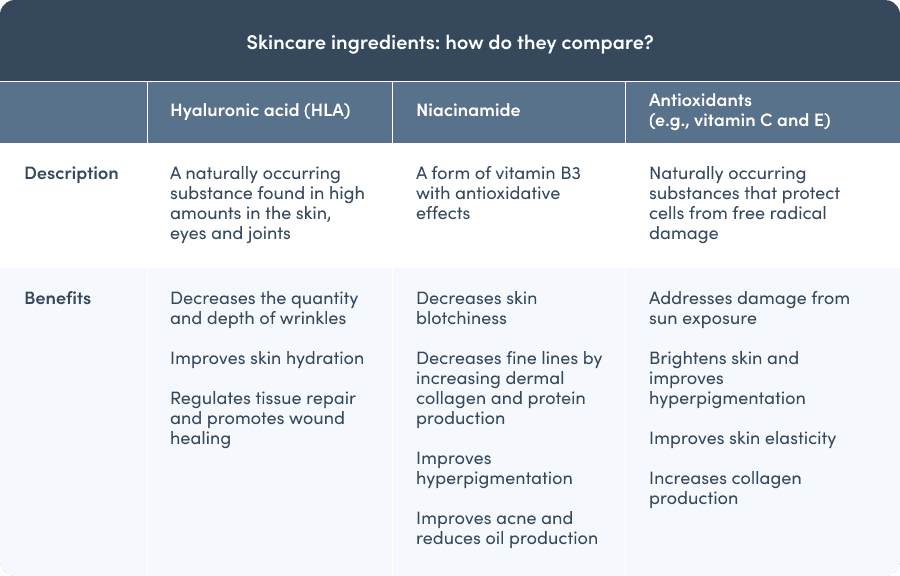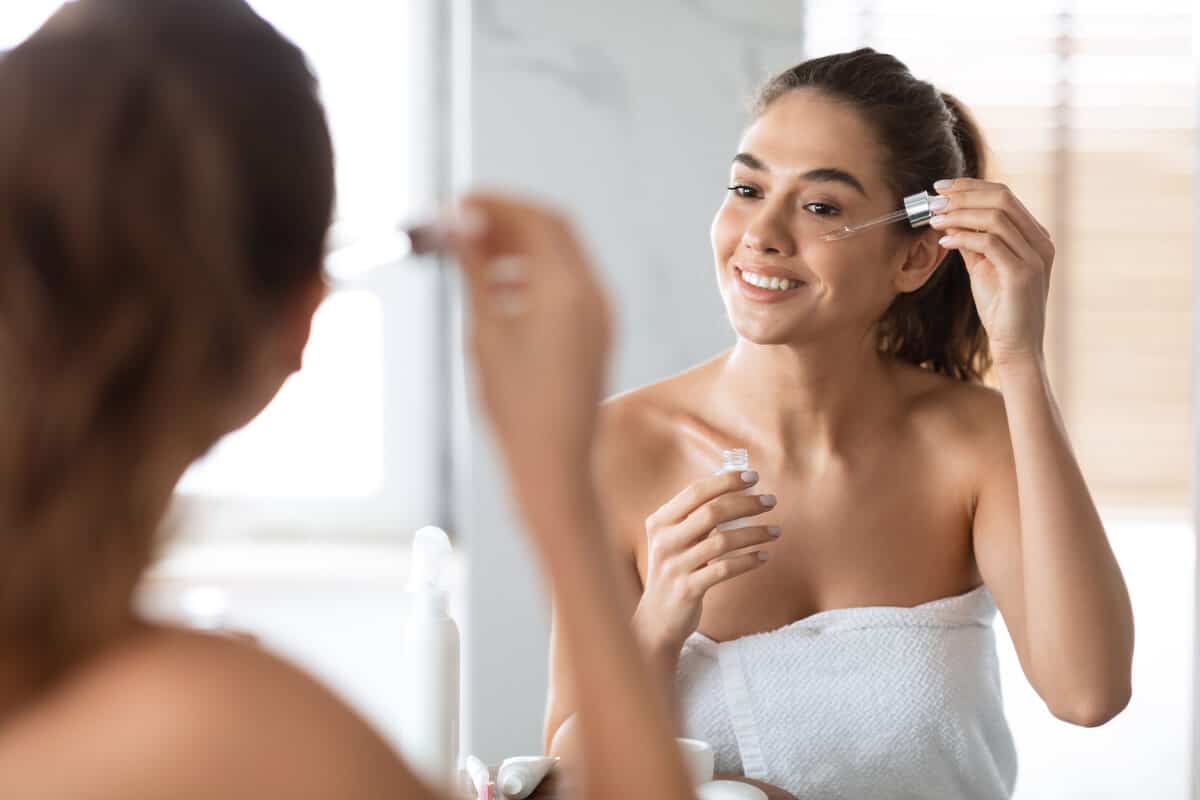
Topical skincare products can be used to improve skin integrity and overall quality.
What are topical skincare products?
Topical skincare products refer to creams, gels, and oils that are applied externally to the skin. Within the scope of skincare, some of these products are referred to as “cosmeceuticals.” Cosmeceuticals are skincare products made from professional grade ingredients. In some cases, cosmeceuticals may be pharmaceuticals requiring a prescription from your healthcare provider. (1)What are topical skincare products used for?
When using skincare topicals, the overall goal is to improve skin integrity and overall quality with a focus on improving glow and radiance. Skin radiance is defined by skin smoothness and the amount of light that it is able to reflect. (11) Skin quality and integrity vary according to age, environmental factors, diet, and other factors. For example, skin may be wrinkled, have variation in color, or look dull due to dehydration, aging, or photoaging resulting from ultraviolet (UV) exposure over a period of time. (5) Using topical skincare products can help prevent or improve skin integrity, quality, radiance, and much more. (11)Common skin conditions
Some skin conditions may use topicals in order to help soothe or treat symptoms. It is always best to consult with your practitioner if you suspect you have, or currently have any of the following:- Acne
- Eczema
- Melasma (brown patches caused by sun exposure or hormonal changes)
- Rosacea
- Solar lentigines (patches of darkened skin)
- Sunburn (11)
Types of topical skincare products
Within skincare, there are three main categories into which topicals can fall. Topicals can be used to treat, moisturize, or prevent and protect. (11)Treatments
There are many different ways in which skincare topicals help to address or alleviate skin conditions based on their ingredients. Some topicals that treat skin texture often use chemical and/or physical exfoliants to help encourage the shedding of old skin cells and the replacement with younger skin cells (cell turnover). Increasing cell turnover helps increase the skin’s radiance, color, and texture. Other topical skincare products used to treat problem areas focus on regulating sebum (oil) or decreasing inflammation. Furthermore, some products may have antimicrobial properties which help to keep bacteria associated with acne in check. (11)Moisturizers
When moisturizing the skin, the focus is on repairing the skin barrier (lipid bilayer) and preventing moisture loss. Key ingredients for repairing and strengthening the lipid bilayer include ceramides and lipids (oils). (11) Ceramides are found in oils; in fact, the sebum your skin produces has some of its own ceramides. Humectants like hyaluronic acid (HLA) are a component in moisturizers that help to draw more water into the area and prevent moisture loss. They may even help repair the lipid bilayer of the skin. (11)Prevention and protection products
Protecting the skin from additional damage is key for a sustainable skincare regime. One of the most common reasons for skin damage is UV and sun exposure. Free radicals may also contribute to skin damage. Ingredients like antioxidants can help scavenge free radicals and protect against further damage. (11) Protecting against damage helps to maintain youthful and radiant skin thus many products with antioxidants are also anti-aging.Popular ingredients in skincare topicals
Topicals use many different ingredients in order to help improve the quality and appearance of the skin. With such a wide range of ingredients, narrowing down what aspect of skin quality to improve can help point in the right direction. Below are examples of ingredients with evidence to show their effectiveness in a variety of ways.
Compare some of the top natural skincare ingredients. The references for this table can be found in the references section below.
Hyaluronic acid (HLA)
Hydrated skin has a plump appearance and has better elasticity. This means that the skin bounces back when pinched. It’s possible that skin can get dehydrated and lose this plumpness. This occurs for a few different reasons, including aging, exposure to UV light, and/or diet. Therefore, increasing hydration within the skin can help restore a youthful appearance. (11) An effective ingredient shown to increase the amount of hydration and elasticity in the skin is hyaluronic acid (HLA). (9) HLA is a component in the body that is most abundant in skin. (8) According to one study, not only did HLA improve hydration, it was also shown to decrease the amount and depth of wrinkles when used consistently for two months. (9) Topical HLA comes in a few different forms including gels, lotions, and serums. While the application of these different types may vary, literature analysis found that each one was able to improve skin appearance such as a decrease in wrinkles and improved hydration. (2)
Hyaluronic acid increases skin hydration.
Niacinamide
Topicals can also be used to treat common skin conditions. One of the most common skin afflictions is acne, which affects approximately 80% of teenagers. (10) There are many different types of ingredients that may alleviate acne, one example is niacinamide gels, also referred to as nicotinamide. Niacinamide is a part of vitamin B3 and is a hydrophilic or water-loving substance. (13) In clinical trials, niacinamide gels were shown to be comparable to the prescription clindamycin gel (topical antibiotic) for treating acne. (12) Additionally, another study was able to show that niacinamide gel was able to favorably alter sebum or natural oil production in skin when used for six weeks. (3)Antioxidants
Antioxidants, such as vitamin C, can be added to topical skincare to help scavenge free radicals as well as treat and prevent skin damage. They can also decrease skin inflammation, improving both acne and visible signs of aging from sun exposure. (11) There are many types of antioxidant ingredients available, and some may have specific effects in addition to general antioxidant properties. A broad look at antioxidants found that they can also help make skin look more youthful by improving skin elasticity. (6) A targeted mix of vitamin C and vitamin E was found to provide UV protection when applied to the skin. (7) Another study found that it may help with anti-aging and improving pigmentation while increasing collagen synthesis. (4)The bottom line
There are many different topical skincare products that can help improve the radiance and overall health of the skin. Choosing the right ingredients for your skin can help improve skin texture, elasticity, and a variety of other factors. Consulting with your healthcare practitioner can help you make the best choice for your skin. Learn more about how to differentiate skincare brands by their quality and ingredients.- Amer, M., & Maged, M. (2009). Cosmeceuticals versus pharmaceuticals. Clinics in Dermatology, 27(5), 428–430.
- Bukhari, S. N. A., Roswandi, N. L., Waqas, M., Habib, H., Hussain, F., Khan, S., Sohail, M., Ramli, N. A., Thu, H. E., & Hussain, Z. (2018). Hyaluronic acid, a promising skin rejuvenating biomedicine: A review of recent updates and pre-clinical and clinical investigations on cosmetic and nutricosmetic effects. International Journal of Biological Macromolecules, 120, 1682–1695.
- Draelos, Z. D., Matsubara, A., & Smiles, K. (2006). The effect of 2% niacinamide on facial sebum production. Journal of Cosmetic and Laser Therapy, 8(2), 96–101.
- Farris, P. K. (2006). Topical vitamin C: A useful agent for treating photoaging and other dermatologic conditions. Dermatologic Surgery, 31, 814–818.
- Lee, C. M. (2016). Fifty years of research and development of cosmeceuticals: A contemporary review. Journal of Cosmetic Dermatology, 15(4), 527–539.
- Lim, J., Lim, C. J., Kim, S., Nam, G., Chang, M., Park, K., et al. (2018). Antiaging and antioxidant effects of topical autophagy activator: A randomized, placebo‐controlled, double‐blinded study. Journal of Cosmetic Dermatology, 18(1), 197–203.
- Murray, J. C., Burch, J. A., Streilein, R. D., Iannacchione, M. A., Hall, R. P., & Pinnell, S. R. (2008). A topical antioxidant solution containing vitamins C and E stabilized by ferulic acid provides protection for human skin against damage caused by ultraviolet irradiation. Journal of the American Academy of Dermatology, 59(3), 418–425.
- Papakonstantinou, E., Roth, M., & Karakiulakis, G. (2012). Hyaluronic acid: A key molecule in skin aging. Dermato-Endocrinology, 4(3), 253–258.
- Pavicic, T., Gauglitz, G. G., Lersch, P., Schwach-Abdellaoui, K., Malle, B., Korting, H. C., & Farwick, M. (2011). Efficacy of cream-based novel formulations of hyaluronic acid of different molecular weights in anti-wrinkle treatment. Journal of drugs in dermatology : JDD, 10(9), 990–1000.
- Purdy, S., & de Berker, D. (2011). Acne vulgaris. BMJ clinical evidence, 2011, 1714.
- Rodan, K., Fields, K., Majewski, G., & Falla, T. (2016). Skincare bootcamp. Plastic and Reconstructive Surgery – Global Open, 4, e1152.
- Shalita, A. R., Smith, J. G., Parish, L. C., Sofman, M. S., & Chalker, D. K. (1995). Topical nicotinamide compared with clindamycin gel in the treatment of inflammatory acne vulgaris. International Journal of Dermatology, 34(6), 434–437.
- Wohlrab, J., & Kreft, D. (2014). Niacinamide – mechanisms of action and its topical use in dermatology. Skin Pharmacology and Physiology, 27(6), 311–315.
- Draelos, Z. D., Matsubara, A., & Smiles, K. (2006). The effect of 2% niacinamide on facial sebum production. Journal of Cosmetic and Laser Therapy, 8(2), 96–101.
- Farris, P. K. (2006). Topical vitamin C: A useful agent for treating photoaging and other dermatologic conditions. Dermatologic Surgery, 31, 814–818.
- Levin, J., & Momin, S. B. (2010). How much do we really know about our favorite cosmeceutical ingredients?. The Journal of clinical and aesthetic dermatology, 3(2), 22–41.
- Papakonstantinou, E., Roth, M., & Karakiulakis, G. (2012). Hyaluronic acid: A key molecule in skin aging. Dermato-Endocrinology, 4(3), 253–258.
- Pavicic, T., Gauglitz, G. G., Lersch, P., Schwach-Abdellaoui, K., Malle, B., Korting, H. C., & Farwick, M. (2011). Efficacy of cream-based novel formulations of hyaluronic acid of different molecular weights in anti-wrinkle treatment. Journal of drugs in dermatology : JDD, 10(9), 990–1000.
- Shalita, A. R., Smith, J. G., Parish, L. C., Sofman, M. S., & Chalker, D. K. (1995). Topical nicotinamide compared with clindamycin gel in the treatment of inflammatory acne vulgaris. International Journal of Dermatology, 34(6), 434–437.





